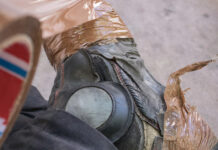Flame resistant (FR) clothing saves lives because it significantly reduces burn injury, gives the wearer escape time, & increases chances of survival. Providing FR clothing demonstrates management’s commitment to safety & employee well-being. It can improve morale, as well as increase safety.
FR clothing can ONLY provide protection if the wearer follows garment manufacturers’ recommendations for proper use:
- Wear garments properly – collars closed, sleeves and cuffs down & secured, shirt tails tucked, closures secured, & other manufacturer recommendations
- Wear looser-fitting garments that provide adequate mobility.
- Do NOT wear non-FR clothing over FR garments – the outermost layer MUST be FR
- Wear only FR or non-melting undergarments (e.g. ,cotton, silk, wool)
- Wash garments thoroughly after each wearing to remove contaminants
- Don’t put on or take off the garment in proximity of flammable gasses, vapors, dusts, or in other potentially explosive environments
- In potentially explosive atmospheres, proper grounding procedures must be used
- Wear garments with the appropriate arc rating as dictated by an electric arc hazard analysis (consult employer if unsure)
Proper cleaning & maintenance of any flame-resistant garment is essential to remove potentially hazardous soils & avoid a build-up of materials that could mask performance. This includes flammable soils & greases as well as other contaminants (such as build up of hard water ions that can coat fibers with flammable material.)
ASTM Standard F 1449 Guide for Care & Maintenance of Flame, Thermal, & Arc Resistant Clothing is a good general reference for care & maintenance of flame resistant & thermal protective clothing. You should always follow garment manufacturer’s care label recommendations & other published instructions or recommendations.
Flammable substances on FR garments will ignite & continue to burn on the surface of the FR garment. Flame-resistant garments should be immediately removed & replaced with clean FR apparel if they become fouled with flammable material. If laundering or dry cleaning cannot remove flammable contaminants, the contaminated garments should be removed from service.
Bleach should not be used when you’re washing FR garments & fabrics. Remember, repeated chlorine bleach launderings will destroy the flame-resistant finish. It’s best to replace bleach with detergents containing bleach alternatives. Industrial laundry detergents containing hydrogen peroxide must NOT be used either.
Most flame-resistant garments can be laundered at home using “normal” detergents & procedures. Most FR products prohibit the use of chlorine bleach for a variety of reasons. FR garments should be laundered separately. Fabric softeners used in the dryer (such as dryer sheets) are safe for use with FR clothing. Don’t have time to do laundry? Many FR products can be industrial laundered, too.
FR garments should be repaired with FR materials & components consistent with the original materials in the garment. Repairing FR garments with non-FR thread or fabric can compromise the thermal performance of the garment. Most FR garment manufacturers or service companies can do repairs or provide the appropriate materials.
For some products, the FR performance is inherent in the chemical composition of the fiber, & therefore the FR performance cannot be removed. For other products, the flame-retardant treatment is guaranteed for the life of the garment, provided that proper laundering procedures are followed.
The wear life of FR clothing is very dependent on the type of fabric used & the quality of the garment construction. Some types of garments can last more than 5 years, while other types may last 9 to 18 months. Garments should be replaced when they’re beyond repair, contaminated, or aesthetically unacceptable.
Garments should be removed from service when they have holes or tears that cannot be repaired, or when the fabric has thinned & become “thread bare.” Garments contaminated with flammable substances should be removed from service if the garment cannot be adequately decontaminated.
Minor repairs that don’t affect the integrity of the garment should be made with like materials by sewing on patches or darning small holes. To provide continued flame resistance, garments must be repaired with materials that have at least the same FR performance characteristics as the original fabric & sewing threads.
The question of garment identification & personalization is always difficult to answer. The only comment of the consensus standards writing organizations, such as NFPA and ASTM International, is that nothing on an article of clothing may increase the extent of wearer injury in case of garment ignition. No OSHA or military standards address this area. SFI, the race car driver’s association, has not addressed this issue either.
When you’re looking for flame-resistant workwear, Working Person’s Store has you covered! Just remember taking care of this workwear is a very important part of staying safe.





